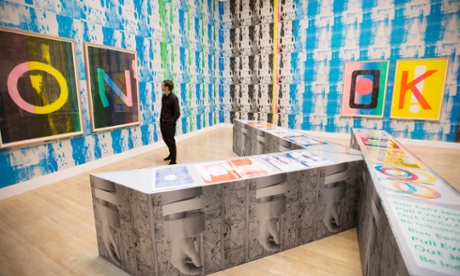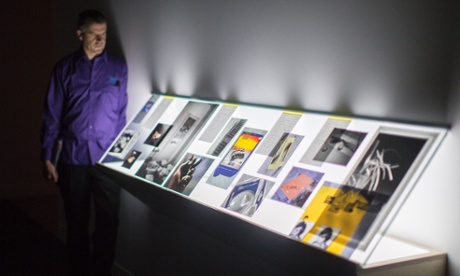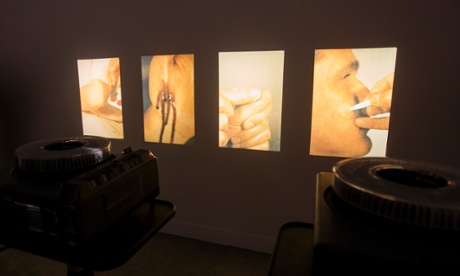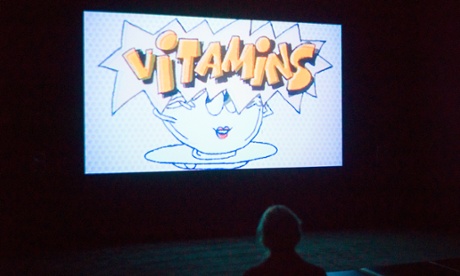The Turner prize show: voices, videos and erotic tickling sticks
Has the Turner prize lost its power to shock? No – thanks to James Richards’s sphincter* shots. But it’s Tris Vonna-Michell’s spellbinding spoken-word travelogues that deserve to win
- Video: 30 years of the Turner prize
- Censored bits and candy-coloured prints – the Turner prize 2014 in pictures
sphincter
Line breaks: sphinc|ter
Pronunciation: /ˈsfɪŋktə
/

Someone is picking wild flowers. Isn’t that nice? Now the flower is being used as a tickling stick. Very amusing. Wait, isn’t that actually a foreskin? Yes, it’s definitely a foreskin. This is Rosebud, a sensual black-and-white film by Turner prize nominee James Richards that interweaves images of aroused flesh and censorship. Provocative photographs with rude bits scratched out are intercut with footage showing the erotic use of flowers. In one sequence, a flower tickles an anus, which reacts by clenching shut.
What a heartening way to celebrate 30 years of the Turner prize. People are always saying the Turner, which shocked the nation with Tracey Emin’s unmade bed and Damien Hirst’s bisected cow, has become tame and middle-aged. It no longer creates the kinds of visceral arguments about the nature of art that it did back in the 20th century, when Rachel Whiteread won both the Turner in 1993 and the K Foundation award for “worst artist of the year”. Nowadays, conceptual art is so widely accepted as part of every aspiring person’s cultural makeup that the Turner causes less controversy than The Great British Bakeoff.
So there’s something nostalgic about sitting in the first room of this year’s show to watch a tightening sphincter filmed in beautiful shadowy greys and blacks. In a second work by Richards, six knitted banners reproduce photographs of people who all have one thing in common: they are standing next to the same bespectacled figure, a man only half there, his face partly cropped out. He is Keith Haring, the New York artist who died after contracting Aids in 1990. But by his third exhibit, Richards is losing his way. It’s a slideshow of people applying fake wound makeup that typifies the dangers of ironic art in the age of the internet, when anybody can find strange images online and play with them. This daft bit of so-so surrealism undermines the apparent passion of his other contributions. It’s pointless.

But if Richards is interesting, the next artist in the show has a strange genius. Tris Vonna-Michell, in his film Finding Chopin: Dans l’Essex, asks a bold question: why was I born in this place in this time? Before hearing this, we have watched picturesque scenes of the coastal marshes of south east England. Vonna-Michell comes from Southend-on-Sea but, as he tells us, he asked his dad one day: why? His father replied (as you do) that he should seek out a French concrete poet called Henri Chopin who could answer his question. Chopin likes quail eggs, he said. Take some as a gift.
All this and a lot more information comes over in fast, ritualistic, cyclic sentences, as Vonna-Michell tells of his search for answers. The search leads to a room where we hear Vonna-Michell’s voice making various pronouncements: “Van Gogh says to Theo in one of his letters: I want to paint solitude”; “I used to be a vegan, now I’m a vegetarian.” Vonna-Michell has a lovely voice. The images in his films – the other tells of a doomed trip to Berlin in search of his mother’s childhood memories – are not important. It is the recorded voice that holds you. He is not, in fact, a film-maker. He is a spoken-word performance artist, usually telling his tangled, rapid, image-packed stories live. Obviously, in the Turner you need to show something, so he’s made these films.
What comes through is that voice, which is funny, engaging and capable of holding your full attention. Vonna-Michell is doing a kind of performance poetry. It’s quietly magnetic even though all you have is his voice and a sequence of images. Of course, he never does find out why he was born in Southend-on-Sea. By the time he tracks down Chopin, who died in Norfolk in 2008, the eggs he bought as a gift are ruined.Vonna-Michell is a true original and I kept coming back to his room with a deepening pleasure. There are no false notes in his installation. It is beautiful.

This is not, however, a vintage Turner year. The other two artists on the shortlist are not worthy of being there. What happened? Has the pool of British art, after 30 years of the Turner, got too small to produce four decent young artists? Or are the judges unable to recognise mediocrity when they see it?
Ciara Phillips makes prints. But so what? Her room is papered with various blurred ones, plus portrait photographs and a kind of booth in the middle where you can read and listen to an alphabet of supposedly thought-provoking topics. There is a purported politics behind it all – campaigns, direct action, buzzwords – but the art does not come across with enough power to make that matter. It’s like a degree show. I’m sure she was top of the class at art school, but she is still going through academic exercises, making prints with no point, just because she can.
At least you can walk in and out of her exhibit. Duncan Campbell demands that you sit down and watch a 54-minute film in which he indulges in so much radical-chic, sub-Godardian posturing that by the end you will either be brainwashed into joining the nearest Maoist splinter group or, more likely, you’ll feel like slashing the seats. It is monstrously arrogant to show a film this long in the Turner Prize. He steals time from the other artists (unless you plan to spend four hours here) and what has he got? What’s he saying that’s so important? It for Others, as the film is called, is a rehash of Marxism and sociological textbooks set against images that include, in the best sequence, the Michael Clark dance company illustrating Marx’s theory of value. The ideas are secondhand and the hectoring tone obnoxious. Part of it is a lecture about a film made by Chris Marker about African masks – still with me? The narrator points out lots of basic stuff about how modern artists falsified the art of Africa. Later, there’s a bit about how artistic value is created. It is all presented as a radical revelation but who doesn’t know the art market is a bit funny?

And yet. Maybe this is a great Turner prize after all, for it juxtaposes such radically different models of what art can be now. Glib reports will say this is a Turner dominated by video, but it’s just a medium, and the uses these artists put it to contrast wildly. For Richards, art is an arrow of desire. For Campbell, it is a theoretical weapon.
It is Vonna-Michell who deserves the Turner when the winner is announced in December. For him, video is just a way of getting at something more elusive and magical: the mystery of live performance. Of the four, he’s the only one whose artistic personality shines through. He seems to have found a highly imaginative way of being in the world. You feel he is an artist when he’s on the loo, as much as he is when he gets up to perform. At the end of his film, he even thanks the audience for listening – what a charmer. The winner of the Turner prize, at least as far as I’m concerned, is the human voice.
• The Turner Prize is at Tate Britain, London SW1, until 4 January.

沒有留言:
張貼留言